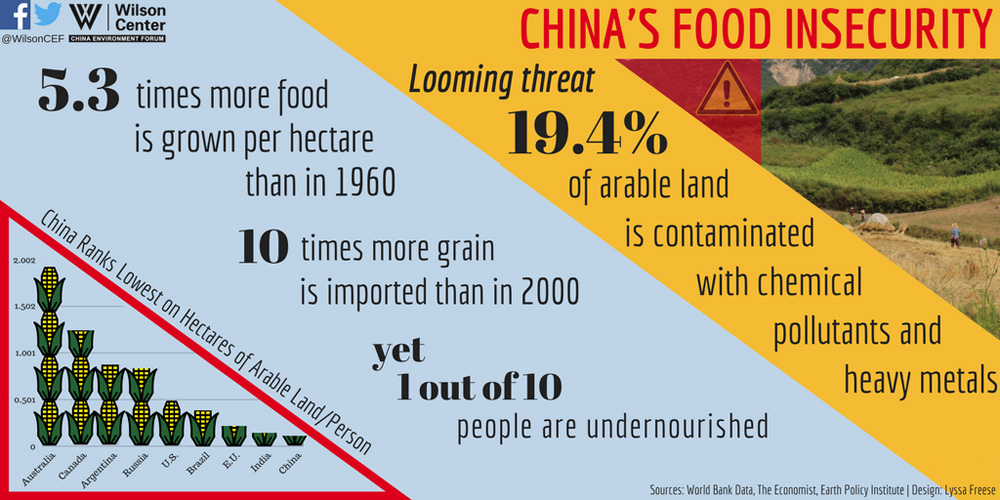-
GMOs: Can U.S.-China Cooperation Address Public Distrust and Increase Food Security?
September 29, 2017 By Gabrielle Rivers
Today, China feeds 1.38 billion people—approximately one-fifth of the global population—with about 10 percent of the world’s arable land. Compared to the United States, where each acre of land feeds one citizen on average, China has only 0.2 acres per person. This people-to-land mismatch helps explain why 9.3 percent of China’s population was undernourished in 2015.
To fight domestic hunger, China strives for a self-sufficiency target of 95 percent, setting its grain reserve levels at twice the rate of international norms. But such high levels have produced rotting grain stockpiles. In addition, pollution from heavy fertilizer and pesticide use on agricultural fields has contaminated an estimated 19.4 percent of arable farmland. And on top of an already stressed agriculture system, Chinese people have a growing appetite for more meat-heavy Western diets, which requires more land to raise livestock and thus reduces the amount of land available for crops. While not the sole solution to these complex problems, biotechnology— genetically modified organisms (GMOs) in particular—may help China improve its food security.
The Lowdown on GMOs
Widespread skepticism and polarization around the issue of GMOs challenges international food and safety regimesBy modifying crops to become more resistant to insects and herbicides, GMO technology can bring enormous benefits to food-insecure regions by increasing food supplies and improving crop quality while diminishing the cost per unit of output. The rapid expansion of GMOs in the United States offers an enticing model for China. U.S. farmers raised yields and profits as they increased the proportion of soybean fields produced with herbicide-tolerant seeds from 17 percent in 1997 to 94 percent in 2014. The on-farm yield increases in U.S. corn averaged about 50-60 percent due to the introduction of insect-resistant seeds in 81 percent of U.S. cornfields. Today, the United States now has more than 20 approved GMO crops, each with tens of variations.
Widespread skepticism and polarization around the issue of GMOs challenges international food and safety regimes. Many believe that the consumption of genetically modified crops may have harmful effects on the human body, including the development of new diseases immune to antibiotics. Additionally, there is limited research on the long-term effects of GMO consumption, causing further anxiety about GMOs.
China’s policymakers have been slow to encourage the technology, due to their reluctance to address public distrust of GMOs and a desire to insulate the Chinese GMO market from competition. Increased cooperation in investment and information sharing with countries like the United States could provide a way to address these challenges.
Government Distrust Drives Fear of GMOs in China
Like most of the world, the Chinese public has concerns about GMO food; in a 2014 Internet survey, 89 percent of Chinese respondents were opposed to or suspicious of genetically modified foods, partially in response to the negative portrayals in Chinese media. Distrust of China’s food safety regulations in China is also widespread; scandals about toxic or tainted products over the past decade include contaminated milk, recycled cooking oil , and—particularly relevant to GMOs—a research experiment where Chinese children were fed genetically modified grains without their parents’ knowledge. Widely reported in the media, this scandal ripped through China, forcing the government to fire the Chinese research team and the affiliated institute of the lead researcher, who was from the United States, to admit ethical violations.
Scandals fuel the Chinese public’s distrust of genetically edited cropsThese scandals fuel the Chinese public’s distrust of genetically edited crops, and present a particular challenge to government-funded research institutes and enterprises that are developing GMO technologies for agricultural production. Two activist groups, Greenpeace international, and a local Maoist group, “Wu You Zhi Xiang” (Utopia), are leading the movement against GMOs in China, objecting to the production of GMO foods and to company’s unclear labelling practices. The two groups led a recent protest at the Nestlé factory in Hong Kong, which produces genetically modified foods for distribution in Asia—even as the company’s products sold in Europe are strictly labelled GMO-free.
Regulatory Barriers Block Widespread Use of GMOs
Since 1997, the Chinese government has granted commercial licenses for planting to only two genetically modified products, cotton and papaya. Five types of genetically modified crops are allowed to be imported: soybeans, corn, cotton, canola, and sugar beet. The government prohibits small-scale planting, with the exception of lab experiments that are a part of the five-stage biosafety certification process for new GMOs. Between 2002 and 2012 alone, the Ministry of Agriculture approved 1,830 five-year biosafety certificates for seven crops; however, none of these crops have been approved for commercial distribution.
In 2015, genetically modified cotton was planted in almost all—3.7 million of a total 3.8 million hectares—of China’s cotton fields. On the other hand, genetically engineered papaya is cultivated on only a meager 7,000 hectares; although this represents an adoption rate of around 93 percent, it is less than 1/100th of a percent of the arable farm land in China.
China’s National Biosafety Committee monitors GMO imports on a case-by-case basis. Since China does not endorse synchronous approval of GM crops, it is often the last to approve them out of many importing countries, postponing authorization for as long as seven years, much longer than the international norm of three years. The requirements of this process have also been a moving target; U.S. companies repeatedly complain that the committee prolongs the process by demanding granular information or asking political questions. The government cites safety concerns as the rationale for this cumbersome authorization structure.
U.S.-China Cooperation Could Provide Opportunities for China’s GMOs
Many of these regulations are in place due to public skepticism. However, new collaborations between China and the United States could spur future GMO development, offering potential ways to both address public fears and reduce regulatory barriers. Through mergers and joint ventures, Chinese companies can gain outward investment opportunities and better capacity, and foreign businesses can circumnavigate trade and approval barriers. For instance, ChemChina’s merger with Syngenta, a European seed and pesticide firm, has made substantial contributions to shifting China’s GMO policy. It catalyzed the re-approval of 14 genetically modified crops, including Syngenta’s Duracade corn, by the Ministry of Agriculture and extended the review process to 2020. Further Chinese investments can continue to prod businesses to advocate for positive GMO narratives and a more open market.
New collaborations between China and the United States could spur future GMO developmentBilateral government engagement could also provide China with opportunities to enhance its technical capacity and finance R&D. The new U.S.-China Comprehensive Economic Dialogue offers a chance to elevate agricultural biotechnology to high-level bilateral interactions. For example, at the most recent meeting in July, China agreed to expedite the approval of two U.S. genetically modified crops.
Information sharing and cooperative platforms could also address the controversy over GMOs. For example, a public-private partnership (PPP) could bring together government agencies, private companies, and trade associations, helping to narrow the knowledge gap between the public and private sector. In Kenya, Genetic Technologies LTD helped the Kenya Agricultural Research Institute and the Jomo Kenyatta University to distribute disease-free, tissue-cultured bananas to poor farmers for planting. Public-private partnerships could be implemented at the micro-level by partnering with individual farmers. According to a 2013 study, farmers selling Bt (Bacillus thuringiensis) cotton saw an increase in income; in addition, they also had healthier diets and became more food-secure, due to having additional resources to purchase food.
Coupled with fresh faces and new deals, GMOs can have a positive effect on health and economic development at the local and global levels. Through increased biotech investment opportunities, bilateral engagement focused on biotechnology, and public-private partnerships, the United States could work alongside China to address public distrust of GMOs, revamp regulations, and contribute to improving the country’s food security.
Gabrielle Rivers is a Master’s student at the George Washington University’s Elliott School for International Affairs.
Sources: Biomed Central: Agriculture and Food Security Journal, Bloomberg, Centre for Agriculture and Biosciences International, Council for Agricultural Science and Technology, Farm Journal Media, Fortune, GWU Master’s Capstone Paper Spring 2017: US-China GMO Trade, International Service for the Acquisition of Agri-biotech Applications, Ministry of Agriculture, People’s Republic of China, PLOS ONE Research Journals and Articles, Sciedu Press Journal on Studies in Asian Social Science, State Council of the People’s Republic of China, The Estey Journal of International Law and Trade Policy, The Financial Times, The New Yorker, Trading Economics.com, United States Department of Agriculture: Economic Research Service, United States Department of Commerce, United States Library of Congress
Photo Credit: GMO corn research field, August 2013, courtesy of Flickr user Lindsay Eyink.
 A Publication of the Stimson Center.
A Publication of the Stimson Center.







